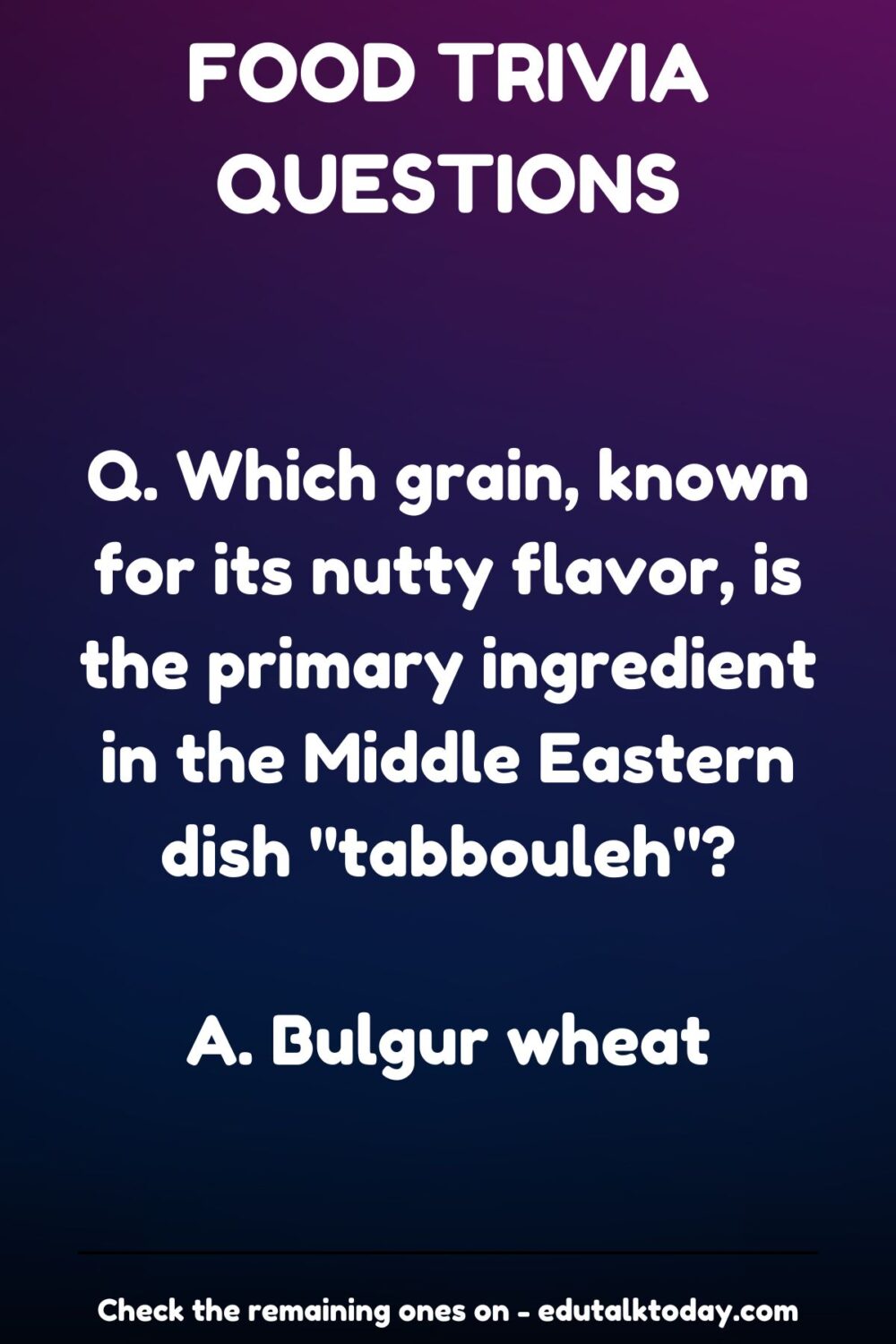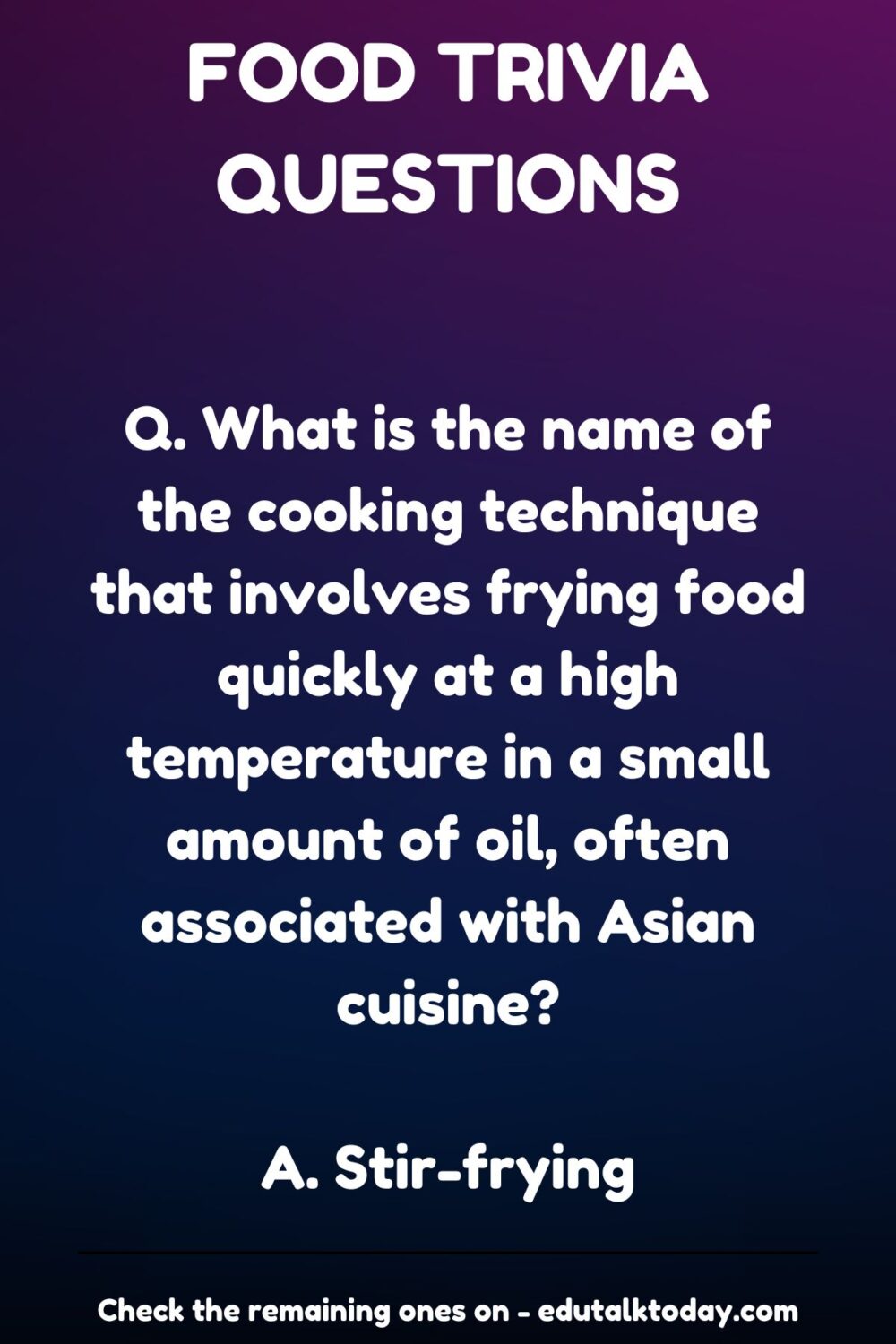45 Trivia Questions About Food
Welcome to the ultimate food trivia showdown, where your appetite for knowledge is about to be tested!
We’ve cooked up some mouthwatering questions that will challenge your taste buds, stretch your culinary imagination, and maybe even make you question your life choices (like, why haven’t you tried durian yet?).
Let’s check them out.
Food Trivia Questions
Q. What is the main ingredient in the traditional French dish “escargot”?
A. Snails
Explanation: Escargot is a classic French delicacy where land snails are cooked and typically served in a garlic, butter, and parsley sauce. The word “escargot” actually means “snail” in French.
Q. Which ancient civilization is credited with first fermenting and drinking beer around 5,000 BCE?
A. Sumerians
Explanation: The Sumerians, who lived in ancient Mesopotamia (modern-day Iraq), are among the first recorded people to brew beer. They even had a goddess of brewing, Ninkasi, and a hymn to her includes a recipe for brewing beer.
Q. What is the name of the chemical compound found in chili peppers that makes them spicy?
A. Capsaicin
Explanation: Capsaicin is the active component in chili peppers that binds to receptors in your mouth and skin, creating the sensation of heat or spiciness.
Q. Which type of rice is traditionally used to make risotto, a classic Italian dish?
A. Arborio
Explanation: Arborio rice is a short-grain rice that is high in amylopectin, a starch that gives risotto its creamy texture. It’s named after the town of Arborio in Italy’s Po Valley.
Q. What is the national dish of Japan that is often served with raw fish?
A. Sushi
Explanation: Sushi is a Japanese dish consisting of vinegared rice (shari) combined with various ingredients (neta), such as raw seafood, vegetables, and occasionally tropical fruits.

Q. What is the name of the protein structure that gives bread its chewy texture?
A. Gluten
Explanation: Gluten is a combination of proteins found in wheat, barley, and rye. When flour is mixed with water, gluten forms a network that traps air bubbles, giving bread its structure and chewy texture.
Q. Which fruit is known as the “king of fruits” and is famous for its strong odor?
A. Durian
Explanation: Durian is a tropical fruit known for its large size, thorn-covered husk, and pungent odor. Despite its smell, it is highly valued in Southeast Asia for its creamy, sweet flesh.
Q. What type of cheese is traditionally used in a Greek salad?
A. Feta
Explanation: Feta is a brined white cheese made from sheep’s milk or a mixture of sheep and goat’s milk. It’s crumbly and tangy, making it a staple in Greek cuisine, especially in salads.
Q. What is the main ingredient in the Middle Eastern dish hummus?
A. Chickpeas (Garbanzo beans)
Explanation: Hummus is a spread or dip made from cooked, mashed chickpeas blended with tahini, olive oil, lemon juice, and garlic. It’s a staple in Middle Eastern cuisine.
Q. Which spice, often used in Indian cooking, is known for its bright yellow color and anti-inflammatory properties?
A. Turmeric
Explanation: Turmeric is a spice made from the root of the Curcuma longa plant. It contains curcumin, a compound that gives it its distinctive yellow color and is known for its health benefits, including anti-inflammatory properties.

Q. What is the traditional method for cooking meat in the South African dish “braai”?
A. Barbecuing (over an open flame)
Explanation: “Braai” is a South African tradition of cooking meat over an open flame, similar to a barbecue. It’s a social event where various types of meat, such as boerewors (sausage), steak, and chicken, are grilled.
Q. Which Italian dessert is made of layers of coffee-soaked ladyfingers and mascarpone cheese?
A. Tiramisu
Explanation: Tiramisu is a popular Italian dessert made with layers of coffee-soaked ladyfingers, mascarpone cheese, cocoa powder, and sometimes liqueur like Marsala wine. The name means “pick me up,” referring to the caffeine in the coffee.
Q. What is the French term for the culinary technique that involves slowly cooking food in a vacuum-sealed bag submerged in water?
A. Sous-vide
Explanation: Sous-vide is a method of cooking where food is vacuum-sealed in a bag and then cooked in a water bath at a precisely regulated temperature. This technique ensures even cooking and helps retain moisture and flavor.
Q. What type of fish is traditionally used in the dish “fish and chips” in the United Kingdom?
A. Cod
Explanation: Cod is the most commonly used fish in the classic British dish “fish and chips.” It is prized for its mild flavor, flaky texture, and ability to fry well.
Q. Which fruit is known as the “alligator pear” due to its bumpy green skin and shape?
A. Avocado
Explanation: The avocado, often called an “alligator pear,” has a rough, green, bumpy exterior and is shaped like a pear. It’s rich in healthy fats and commonly used in dishes like guacamole.

Q. What is the primary ingredient in the Japanese dish “miso soup”?
A. Fermented soybean paste (Miso)
Explanation: Miso soup is a traditional Japanese soup consisting primarily of a dashi stock and miso paste. Miso is made from fermented soybeans, and the soup often includes ingredients like tofu, seaweed, and green onions.
Q. Which country is the world’s largest producer of olive oil?
A. Spain
Explanation: Spain is the largest producer of olive oil, accounting for about 45% of the world’s production. The Andalusian region, particularly Jaén, is known for its vast olive groves.
Q. What is the name of the dessert made by layering filo pastry with chopped nuts and honey?
A. Baklava
Explanation: Baklava is a rich, sweet pastry made of layers of filo dough filled with chopped nuts and sweetened with syrup or honey. It is commonly found in Middle Eastern, Greek, and Turkish cuisines.
Q. What is the name of the cooking technique that involves frying food quickly at a high temperature in a small amount of oil, often associated with Asian cuisine?
A. Stir-frying
Explanation: Stir-frying is a technique where ingredients are cooked quickly in a small amount of hot oil, usually in a wok. This method retains the ingredients’ texture, flavor, and color.
Q. What is the name of the Italian bread that is baked with olive oil and often topped with herbs and garlic?
A. Focaccia
Explanation: Focaccia is a flat oven-baked Italian bread similar in style and texture to pizza dough. It is often seasoned with olive oil, herbs, garlic, and sometimes topped with tomatoes or olives.

Q. Which fruit is traditionally used to make the French dessert “tarte Tatin”?
A. Apples
Explanation: Tarte Tatin is a classic French dessert where apples are caramelized in butter and sugar before being baked under a pastry crust. The tart is then flipped over to serve, revealing the caramelized fruit on top.
Q. What type of nut is used to make traditional marzipan?
A. Almonds
Explanation: Marzipan is a sweet confection made from ground almonds, sugar, and egg whites. It is often molded into shapes or used as a filling in pastries.
Q. What is the Japanese dish that involves grilling bite-sized pieces of meat, often chicken, on skewers?
A. Yakitori
Explanation: Yakitori is a popular Japanese dish consisting of skewered and grilled chicken, often served with tare sauce or simply seasoned with salt. It is a common street food and izakaya (Japanese pub) dish.
Q. What type of cheese is traditionally used in the Italian dish “lasagna”?
A. Ricotta
Explanation: Ricotta is a creamy, mild cheese traditionally used in lasagna, a layered pasta dish. Along with ricotta, lasagna often includes mozzarella, parmesan, and a meat or vegetable sauce.
Q. Which spice is known as the “queen of spices” and is commonly used in Indian cuisine, especially in chai tea?
A. Cardamom
Explanation: Cardamom is a highly aromatic spice that is often called the “queen of spices.” It is used extensively in Indian cuisine, particularly in curries and chai tea, for its sweet, floral, and slightly spicy flavor.

Q. What is the name of the small, round French pastry that is typically filled with cream and topped with chocolate?
A. Profiterole (Cream Puff)
Explanation: Profiteroles, also known as cream puffs, are small round pastries made from choux dough. They are typically filled with whipped cream, pastry cream, or ice cream and topped with chocolate sauce.
Q. What is the name of the Mexican dish made from corn dough filled with various ingredients, wrapped in corn husks, and steamed?
A. Tamales
Explanation: Tamales are a traditional Mexican dish made from masa (corn dough) filled with meats, cheeses, or other fillings, then wrapped in corn husks or banana leaves and steamed.
Q. What is the French term for a mixture of diced vegetables, usually onions, carrots, and celery, used as a flavor base for soups and stews?
A. Mirepoix
Explanation: Mirepoix is a French culinary term for a mixture of diced onions, carrots, and celery sautéed in butter or oil. It serves as the flavor foundation for many soups, stews, and sauces.
Q. Which fish is most commonly used to make “gravlax,” a Scandinavian dish of cured salmon?
A. Salmon
Explanation: Gravlax is a traditional Scandinavian dish made by curing salmon with a mixture of salt, sugar, and dill. The name “gravlax” comes from the old practice of burying the fish in sand for curing.
Q. What is the name of the traditional Spanish rice dish cooked with saffron and typically includes seafood, meat, and vegetables?
A. Paella
Explanation: Paella is a Spanish dish originally from Valencia, made with rice, saffron, and a variety of ingredients such as seafood, chicken, rabbit, and vegetables. It’s traditionally cooked in a wide, shallow pan called a paellera.

Q. What is the name of the French dessert that consists of a custard base topped with a layer of hardened caramelized sugar?
A. Crème Brûlée
Explanation: Crème brûlée is a classic French dessert made from a rich custard base, typically flavored with vanilla, and topped with a layer of sugar that is caramelized until it forms a hard, glass-like crust.
Q. What is the name of the Middle Eastern dip made from roasted eggplants, tahini, lemon juice, and garlic?
A. Baba Ganoush
Explanation: Baba Ganoush is a creamy dip made from roasted eggplants blended with tahini, lemon juice, garlic, and sometimes other seasonings. It’s a popular appetizer in Middle Eastern cuisine.
Q. Which Italian cheese is known for its strong aroma and is often used in Caesar salads?
A. Parmigiano-Reggiano
Explanation: Parmigiano-Reggiano, often known as Parmesan, is a hard, aged cheese from Italy with a robust flavor and aroma. It’s frequently grated over Caesar salads and other dishes for its savory, umami-rich taste.
Q. What is the main ingredient in the Indian bread “naan”?
A. Wheat flour
Explanation: Naan is a leavened flatbread made from wheat flour, often cooked in a tandoor oven. It is soft, slightly chewy, and typically served with curries and other dishes in Indian cuisine.
Q. Which traditional Japanese dish is made by fermenting soybeans with a bacterial culture, giving it a sticky texture and strong smell?
A. Natto
Explanation: Natto is a Japanese food made from fermented soybeans, known for its distinctive smell, sticky texture, and strong flavor. It’s often eaten with rice and is considered a health food in Japan.

Q. What is the name of the spicy Hungarian soup made with paprika and meat, often served with bread?
A. Goulash
Explanation: Goulash is a hearty soup or stew from Hungary, traditionally made with meat (often beef), onions, and a generous amount of paprika. It’s a national dish and is known for its rich, spicy flavor.
Q. Which Scandinavian country is famous for its dish “smørrebrød,” an open-faced sandwich usually made with rye bread?
A. Denmark
Explanation: Smørrebrød is a traditional Danish open-faced sandwich typically made with buttered rye bread and topped with ingredients like cold cuts, fish, cheese, and garnishes. It’s a staple of Danish cuisine.
Q. What is the key ingredient in the French dish “Coq au Vin”?
A. Chicken (Rooster)
Explanation: Coq au Vin is a classic French dish where chicken (traditionally a rooster) is braised in red wine with mushrooms, onions, bacon, and garlic. The dish is slow-cooked to develop deep flavors.
Q. Which fruit, native to Central and South America, is used to make guacamole?
A. Avocado
Explanation: Avocado is the primary ingredient in guacamole, a Mexican dip made by mashing avocados and mixing them with lime juice, salt, onions, tomatoes, and sometimes other seasonings like cilantro and garlic.
Q. What is the name of the fermented cabbage dish that is a staple in Korean cuisine?
A. Kimchi
Explanation: Kimchi is a traditional Korean side dish made from fermented vegetables, primarily napa cabbage and radishes, seasoned with chili pepper, garlic, ginger, and other spices. It’s known for its pungent flavor and health benefits.

Q. Which French cooking technique involves simmering meat and vegetables in liquid for an extended period to create a rich, flavorful dish?
A. Braising
Explanation: Braising is a slow-cooking technique where meat and vegetables are first seared and then slowly cooked in a covered pot with a small amount of liquid. This method tenderizes the meat and infuses it with flavor.
Q. What is the name of the flatbread commonly used in Greek cuisine, especially for wraps like gyros?
A. Pita
Explanation: Pita is a round, soft flatbread commonly used in Greek cuisine. It can be split open to form a pocket or wrapped around fillings such as meat, vegetables, and sauces to make dishes like gyros and falafel.
Q. Which French pastry, shaped like a crescent, is known for its flaky texture and is often eaten for breakfast?
A. Croissant
Explanation: The croissant is a buttery, flaky pastry of Austrian origin but popularized by French cuisine. It’s made from laminated dough, which creates its light, airy texture, and is commonly enjoyed with coffee at breakfast.
Q. What is the name of the Japanese technique for cutting vegetables into thin, uniform matchstick strips?
A. Julienne
Explanation: Julienne is a French cooking technique adopted worldwide, including in Japanese cuisine, where vegetables are cut into thin, uniform matchstick-shaped pieces. It’s often used for garnishing or in salads.
Q. Which grain, known for its nutty flavor, is the primary ingredient in the Middle Eastern dish “tabbouleh”?
A. Bulgur wheat
Explanation: Tabbouleh is a salad made from finely chopped parsley, tomatoes, mint, onion, and soaked bulgur wheat, dressed with olive oil and lemon juice. Bulgur gives the dish its distinctive, slightly chewy texture.
Q. What is the name of the traditional Chinese cooking method that uses high heat and a small amount of oil to quickly cook food while stirring constantly?
A. Stir-frying
Explanation: Stir-frying is a Chinese cooking technique where ingredients are cooked quickly in a wok over high heat with a small amount of oil. The method preserves the color, flavor, and nutrients of the food.
